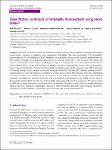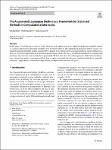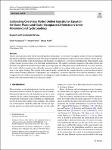Search
Author
- T. S., Amer (2)
- A., Meana-Fernández (1)
- A., Moreau (1)
- Aaliya, Sarfaraz (1)
- next >
Subject
- 17–4 PH stainless stee... (1)
- 1D-CNNs (1)
- 3CL protease (1)
- Absorbance measurement (1)
- next >
Search Results
A non-destructive diagnostic method based on deflection analysis for monitoring the post-elastic response of beams was developed, and a diagnostic indicator was proposed. The indicator was defined as the second moment of the normalised curvature function about the mid-span, where the curvature was computed from the normalised deflection function. Elastic reference values of the indicator were computed for simply supported beams under uniformly distributed load, three-point, and four-point bending. Development of the indicator under progressive loading was examined with the help of finite element analyses. The indicator value monotonically decreased with increasing deformation provided that maximum bending moment was located between 0.41L and 0.59L, where L is the span of the beam. I... |
Dimensions and surface roughness of magnesium alloy tubes were evaluated to elucidate the flattening behavior of asperity on the outer surface and the optimal condition for achieving thin wall and high surface quality in the combined process of the hollow sinking after die-less mandrel drawing. ZM21 tubes were drawn using a die after die-less mandrel drawing. Dimensions and surface roughness were measured, and the stress state of the asperity during hollow sinking was evaluated using finite element and slab methods. The results indicated that in hollow sinking after die-less mandrel drawing when the speed ratio was large, both a thin wall and high inner and outer surface qualities can be achieved under low die reduction, where the outer surface roughness was the least, owing to rela... |
Laser melting can be conducted in two different process regimes, the conduction and the keyhole mode, which exhibit significantly different characteristics, dynamics, and stability and are highly sensitive to a magnitude of process parameters. Despite these differences and the resulting high relevance of the prevailing process regime for process development, the regime is commonly deduced after specimen testing. An identification of the regime parallel to the process could speed up the process development of, for example, laser beam welding or laser-based powder bed fusion of metals. Therefore, the possibility of an in situ regime identification under process-near conditions is the aim of these investigations. For this, the absorbance is measured in situ by using an integrating sphe... |
Servo press forming machines are advanced forming systems that are capable of imparting interrupted punch motion, resulting in enhanced room temperature formability. The exact mechanism of the formability improvement is not yet established. The contribution of interrupted motion in the ductility improvement has been studied through stress relaxation phenomena in uniaxial tensile (UT) tests. However, the reason for improved formability observed when employing servo press is complicated due to the additional contribution from frictional effects. In the present work, an attempt is made to decouple the friction effect on formability improvement numerically. The improved formability is studied using a hole expansion test (HET). |
In this paper we will present a review of recent advances in the application of the augmented Lagrange multiplier method as a general approach for generating multiplier-free stabilised methods. The augmented Lagrangian method consists of a standard Lagrange multiplier method augmented by a penalty term, penalising the constraint equations, and is well known as the basis for iterative algorithms for constrained optimisation problems. Its use as a stabilisation methods in computational mechanics has, however, only recently been appreciated. We first show how the method generates Galerkin/Least Squares type schemes for equality constraints and then how it can be extended to develop new stabilised methods for inequality constraints. Application to several different problems in computati... |
Various elasto-plastic models for the rate-independent deformation, various elasto-viscoplastic models for the rate-dependent deformation and their combinations have been proposed during a long time more than one or more centuries. Firstly, the history of the development of the elastoplasticiy and the elasto-viscoplasticity is reviewed comprehensively. Unfortunately, each of these models possesses their own drawbacks and limitations. The unified constitutive equation of the elasto-plastic and the elasto-viscoplastic deformations is provided by incorporating the subloading surface model into the overstress model in this article, which is capable of describing the monotonic and the cyclic loadings at the general rate ranging from the quasi-static to the impact loading. |
Moving-object tracking using a pan–tilt camera setup is quite a well-known task in robotics. However, the presented research addresses specific properties of the tracked object and introduces novel features to the pan–tilt camera control strategy. Pan–tilt camera control does not operate in an isolated environment. It is a part of the visual servoing system with specific goals. The system has to fulfill certain purposes, which affect its configuration and functionality. The pan–tilt system aims at keeping the visually tracked object within the middle of the image. At the same time, the overall visual servoing efficiently recognizes and tracks the object enabling its grasping by the robot arm. It uses a predictive strategy utilizing specific second-order linear models for pan and til... |
The water-lubricated thrust bearings of the marine rim-driven thruster (RDT) are usually composed of polymer composites, which are prone to serious wear under harsh working conditions. Ultrasonic is an excellent non-destructive monitoring technology, but polymer materials are characterized by viscoelasticity, heterogeneity, and large acoustic attenuation, making it challenging to extract ultrasonic echo signals. Therefore, this paper proposes a wear monitoring method based on the amplitude spectrum of the ultrasonic reflection coefficient. The effects of bearing parameters, objective function, and algorithm parameters on the identification results are simulated and analyzed. Taking the correlation coefficient and root mean square error as the matching parameters, the thickness, soun... |
The technology of functionally graded concrete (FGC) is a new methodology in the field of concrete construction, striving for mass savings by adjusting the elements interior design. A promising approach herein is meso-gradation, where concrete hollow spheres are placed inside the formwork before casting the element; this allows up to 50% mass savings without a loss in load-bearing capacity, whilst also ensuring recyclability compared to e.g. bubble decks. In order to prevent damage/displacement of the spheres during automated fabrication, the extruded concrete flow must avoid the spheres, whilst neatly covering the elements area in order to prevent cavities. Both requirements formulate a complex path planning problem that must be solved in order to achieve automated fabrication. In ... |
Brain-computer interfaces (BCIs) are emerging as a promising tool for upper limb recovery after stroke, and motor tasks are an essential part of BCIs for patient training and control of rehabilitative/assistive BCIs. However, the correlation between brain activation with different levels of motor impairment and motor tasks in BCIs is still not so clear. Thus, we aim to compare the brain activation of different levels of motor impairment in performing the hand grasping and opening tasks in BCIs. |









